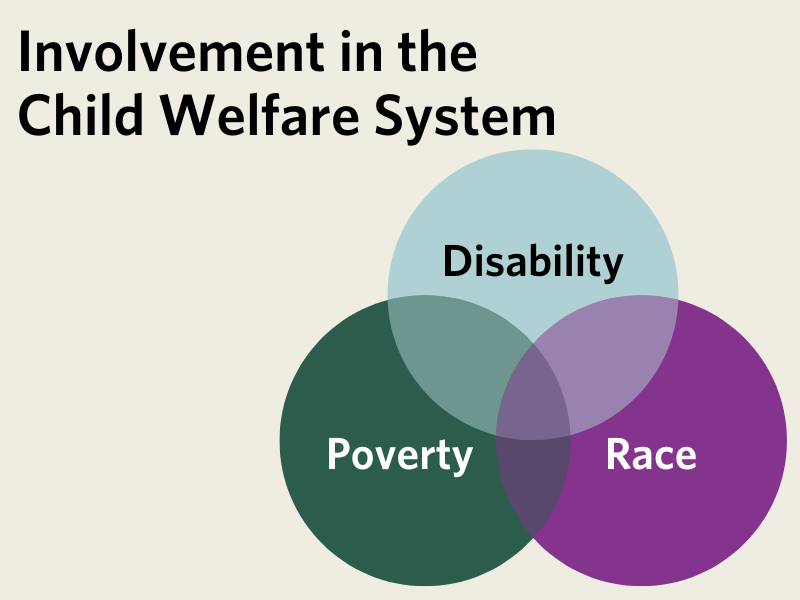Recurrence of Substantiated Reports of Child Maltreatment by Low-Income Parents with Disabilities: The Importance of Poverty and Race
Minhae Cho & Elizabeth Lightfoot · May 2022
Download PDF | Plain-language version

Introduction
Parents with disabilities are overrepresented within the child welfare system (National Council on Disability, 2012). Furthermore, researchers have documented biased and discriminatory policies and practices within the child welfare system, including a lack of accessible supports and services (Albert & Powell, 2020). However, there is very limited information about the long-term involvement of parents with disabilities and their children. Also, while contextual factors such as poverty and racism generally increase the risk of child welfare system involvement, there is little information about how these factors impact parents with disabilities. This is a critical gap, since adults with disabilities are more likely to be poor than adults without disabilities (Brucker et al., 2015), and racism and ableism interact to compound marginalization in other sectors, such as healthcare (Akobirshoev et al., 2020).
Main Findings
Low-income parents with disabilities, compared to low-income parents without disabilities, did not have a higher risk for recurring substantiated reports of abuse or neglect, after accounting for other risk factors. For parents with and without disabilities, Black parents were more likely than White parents to have recurring substantiated reports. For parents with disabilities, being older, receiving SNAP benefits (a measure of poverty), having a daughter, and having a child in out-of-home care increased the risk for having recurring substantiated reports. Having a GED or higher education degree and living with a larger number of family members decreased the risk for disabled parents. For parents without disabilities, family instability (having a change in the children’s primary caregivers) increased the risk.
Policy Implications
The findings of this study highlight the complex relationships between poverty, race, disability, and child welfare involvement. For example, a parent with a disability experiencing financial challenges might not be able to obtain necessary parenting supports, if the available supports are not accessible.
Also, in light of the fact that disability itself was not a risk factor for recurrence, factors related to the poverty often associated with living with a disability may partially explain the higher levels of involvement of parents with disabilities in the child welfare system, as identified by other studies. To develop and disseminate more effective interventions that prevent children of low-income caregivers with disabilities from repeated system involvements, it is fundamental to understand their unique challenges and needs, and to develop services and supports that are accessible, individually tailored, and culturally competent to meet the needs of caregivers from racial and ethnic minority communities.
Methods
This study used the Longitudinal Studies of Child Abuse and Neglect dataset to compare 127 low-income parents with disabilities to a matched sample of 254 low-income parents without disabilities. These two groups of parents were compared for the rates of repeated substantiated reports of abuse or neglect. These two groups of parents were also compared for what factors (i.e., poverty, race) increased the risk of repeated substantiated reports of abuse or neglect. A report is substantiated when the child welfare agency finds that abuse or neglect is likely to have occurred. Recurring substantiated reports means that this happened more than one time.
References
Akobirshoev, I. Mitra, M., Parish, S. L., Valentine, A., & Simas, T. A. M. (2020). Racial and ethnic disparities in birth outcomes and labor and delivery charges among Massachusetts women with intellectual and developmental disabilities. Intellectual and Developmental Disabilities, 58(2), 126–138. https://doi.org/10.1352/1934-9556-58.2.126
Albert, S. M., & Powell, R. M. (2020). Supporting disabled parents and their families: Perspectives and recommendations from parents, attorneys, and child welfare professionals. Journal of Public Child Welfare, 15(3), 1–35. https://doi.org/10.1080/15548732.2020.1751771
Brucker, D. L., Mitra, S., Chaitoo, N., & Mauro, J. (2015). More likely to be poor whatever the measure: Working-age persons with disabilities in the United States. Social Science Quarterly, 96(1), 273–296. https://doi.org/10.1111/ssqu.12098
National Council on Disability. (2012). Rocking the cradle: Ensuring the rights of parents with disabilities and their children. https://www.ncd.gov/publications/2012/Sep272012
How to Cite This Brief
National Research Center for Parents with Disabilities. (2022). Recurrence of Substantiated Reports of Child Maltreatment by Low-Income Parents with Disabilities: The Importance of Poverty and Race. Brandeis University, Waltham, MA.
